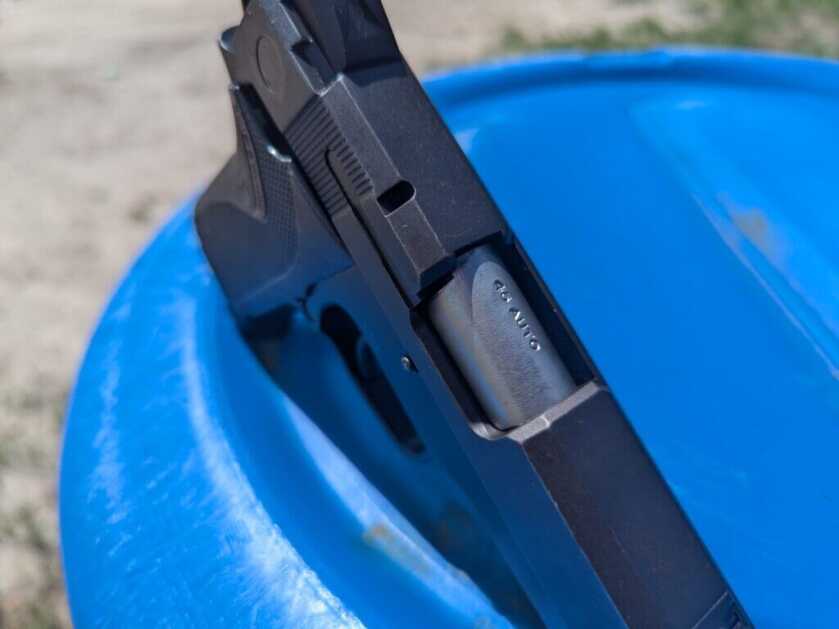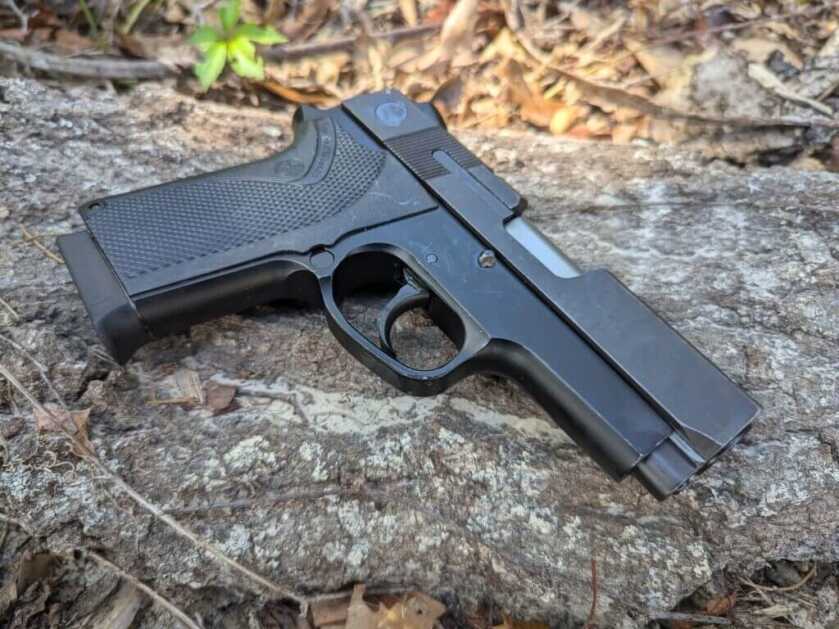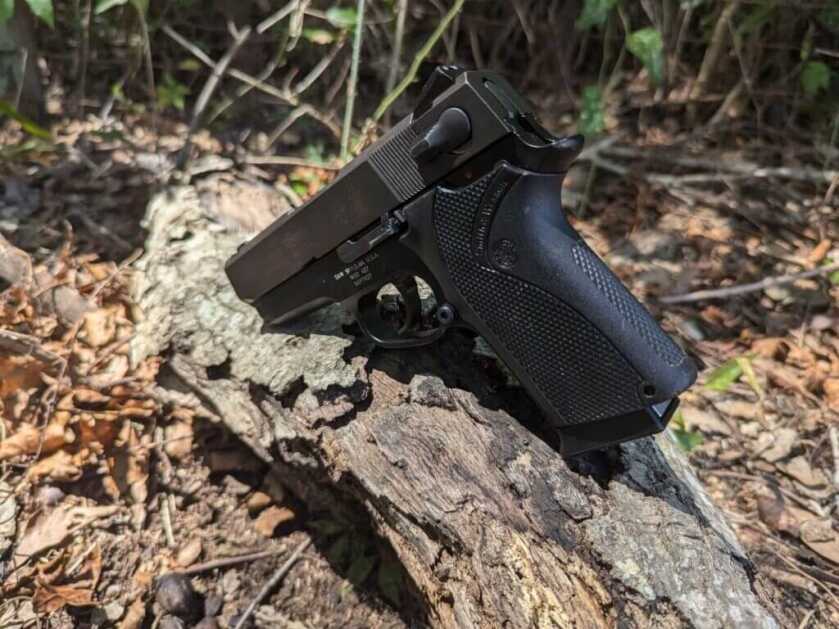Estimated reading time: 9 minutes
When I saw the price of my latest handgun purchase, a S&W 457, I was a bit shocked. It wasn’t expensive, but it was the highest price on a Third Gen I’d seen in quite some time. It dawned on me that the world realized that the S&W metal frame DA/SA guns are pretty good handguns. We are seeing a renewed interest in these weapons, upping the demand significantly, and the price followed suit. This is a fairly interesting revelation to me.
A good majority of third-generation guns don’t even come with Picatinny rails! Optics cuts? Yeah, right. How will we attach all our accessories without optics cuts and rails? How do we adjust the grip size without backstraps? How will we master two trigger pulls? The demand and renewed interest come from the fact that these are still pretty good guns.
Table of contents

They may not be the bargain they once were, but they’re still a steal when considering the prices of other metal-frame guns. S&W’s own M&P 2.0 Metal retails for nearly 900 dollars, and the Walther PDP Steel Frame has an MSRP of 1,899. So, spending 400 on a S&W 3rd Gen is a pretty sweet deal in comparison.
Decoding the S&W 457
The S&W 457 is a third generation S&W semi-autoamtic pistol. Typically, S&W 3rd-generation guns have four-digit model numbers, and second-generation guns have three-digit model numbers. That’s the rule of thumb. An exception is the ‘budget’ variants of the Third Generation. The 457 falls into the value line of S&W Third Generation guns.

When they hit the market, S&W Third Generation guns weren’t cheap. Glock was entering the same market, and Glocks were a lot cheaper than S&W Third Generation guns. A Glock was several hundred dollars cheaper than a 3rd S&W. S&W created a series of budget mind guns in 9mm, .40 S&W, and .45 ACP to compete.

Guns like the 457 featured much simpler designs. They lack front and rear texturing on the grip. The guns use polymer sights, and the safety/decockers were single-sided rather than ambidextrous. The finish was matte and certainly didn’t have the charm of the stainless designs.
The 457 Inside and Out
As the first two digits imply, this is a .45 ACP gun. It falls between what we typically call a subcompact and compact. It’s bigger than a Glock 26 but smaller than a Glock 19. The gun has a 3.75-inch barrel and an overall length of 6 13/16 inches. The alloy steel frame doesn’t save much weight, and it weighs 26 ounces.
We get a single-stack seven-round magazine that’s doing a fine imitation of a 1911 magazine. Sadly, S&W didn’t choose the widely available 1911 mags for these guns, so we are stuck with proprietary magazines that tend to be pricey.

As a product of the era, they come with a magazine safety. According to the internet, it’s removable through the rear sight of all places. I’m not going to mess with my internals, though. The gun also has a manual, slide-mounted safety that doubles as a decocker. It’s easy enough to use, but the manual safety on a double action seems a bit overkill, and since it’s a decocker, you can’t carry it locked and cocked like a CZ series gun.
The gun does have a DA/SA design, but the hammer is bobbed to sit flush with the slide. Upon initial inspection, I assumed it was a DAO gun. Something about bobbed hammers always puts me into that DAO mindset.

The sights are a standard three-dot variety. The grips are plastic and textured, but not a whole lot. The gun’s edges are mostly melted, and it would seemingly conceal quite well. It’s not super fancy, but the weapon has a solid base for a defensive pistol.
Chucking Ash Trays
I’ve heard .45 ACP JHPs called ashtrays for how large they are, and it’s easy to see why. It’s a big bullet with a huge hollow point. It was the combat round of choice for decades and still works quite well today. It doesn’t do much that 9mm can’t do in the modern era, but it’s still a very functional option.
I started by shooting defensive ammo from the 457 to get an idea of how it would handle a fight with realistic ammo. My results were a mixed bag. At first, it was fine, easy to control, and easy to keep on target as I blasted through double taps, a Bill Drill, and failure-to-stop drills. What made it fall apart was something called summer in the southeast.

Once my hands started sweating, the gun became harder to hold. This is caused by two main issues. First, the grip seems wide when measured from under the trigger to the backstrap. It’s uncomfortably large, and I don’t know why. It’s seemingly wider than any 1911, even though both use single-stack magazines.
Second, the front strap lacks any grip texture, and the included plastic grips are hardly aggressive. This makes it easy for the gun to slip around in wet, sweaty hands. Controlling recoil becomes challenging when the gun slides around in your grip. It’s tough to ratchet down, and I saw my strings of fire grow into larger groups, and my times for drills increase.

I need some grip tape, stat! If I planned to use the 457 defensively, that would be the first and only upgrade I’d apply.
More On Ergonomics
The gun’s safety/decocker is easy to access with your thumb. I was raised on the Beretta M9, so I learned this long ago. It’s not as ergonomic as a frame-mounted design, but with a little work, you can get decently quick at deactivating the safety on the draw. I’d carry the gun with the hammer down and safety off because I don’t see the need for a safety on a double-action trigger.

The slide release and lock are nicely sized. In the 1990s, people weren’t shy about using a chunky slide release on their combat pistols. These days, slide locks/releases are micro-sized. They’re very easy to engage and make those reloads much faster. The magazine release is small but easy to reach, and the magazine flies out of the gun when pressed.
The grip lacks some ergonomic appeal. It’s wide and mostly textureless, but overall, it’s a fairly solid design.
Popping Steel
Big three-dot sights easily line up and make throwing those chunky ashtrays easy. At seven yards, I was putting five-shot groups into a playing card. I fired Bill Drills at seven yards and chucked six of those big 230-grain rounds into the A-Zone without missing a beat. I could keep the gun on target as long as I kept my hands dry.
Seven to fifteen yards is a joke for this gun, so how does it handle at 25 yards? Quite well! I knocked down twin poppers without wasting a shot. I could routinely hit an IPSC steel target at 25 yards with a consistent cadence of less than a second per shot.

The double-action trigger surprised me. It’s heavy and long but remarkably smooth. It glides rearward without grit. The single action trigger brings us the light and short trigger we all love. The single action helps pair down those par times with such a short pull and reset.
READ MORE: FLUX Raider X – The Ultimate P320 Upgrade
It also always went bang and fired a mix of 230-grain ball, 230-grain JHPs, and 180-grain JHPs. It fed each round reliably and didn’t give up the ghost.
An Old-School Approach
The modern market lacks metal-frame DA/SA guns, and it most certainly lacks compact 45s. If you have an itch for such a gun, the 457 series is still viable. Admittedly, finding holsters is tough but not impossible. It’s a good shooter but does have some issues with the grip. Grip tape is a cheap and easy fix.

The S&W third-generation guns, as a whole, are very well-made and reliable weapons that will likely only continue to grow in popularity. Luckily, there are plenty spread across Guns America, so snatch one up now before they reach the stratosphere price-wise.
*** Buy and Sell on GunsAmerica! ***


The 457 is the same size as the 4516 and the 4553. So searching for holsters under those other model numbers may help. Hogue makes rubber grips but they are bigger across and a little squishy. To me, those makes me feel like I am shooting a double-stack 40. They also make some checkered wood grips. those might be the solution. – S&W Compact Semi-Auto. 4516.
Those short recoil rods are hard to find, but 4566 (the 4-1/2″ barrel) are available – have one cut to fit. Springs are available thru Wolff. Shame S&W has decided not to support with parts. Seems like easy extra money.
Location of the safety selector is horrible– bites the fingers/thumb when operating the slide. You’d never see this in a modern design.
I love most 3rd G en S&Ws. I bought a very nice 3914 last summer, along with an equally nice 910. I went through the academy with a 3rd Gen S&W (3914), so they’ve been a nice trip down ‘Memory Lane’. The 3914 is an absolute joy to carry/shoot with Speer 124gr +P Gold Dots.
My first duty gun was a used S&W 59. I quickly came to love that gun and makes me sick that I sold it all those years ago. I have a soft spot for the entire series of guns. The only one I have anymore is a S&W 469. It’s heavy but it’s pretty small and has good capacity with its double stack mag. People are starting to snatch up these guns and driving the prices up just as fast.
A picture of the cartridges tested would be nice, in particular the ash trays.
The old Speer 200gr ‘Flying Ash Tray’ came immediately to mind. S&W .45s were the only production autos to feed the stubby rounds reliably. There is a good YT video on those rounds if interested.